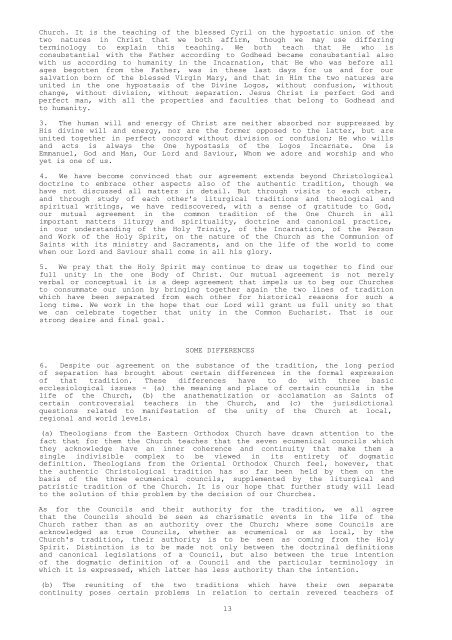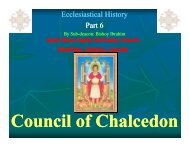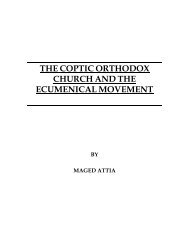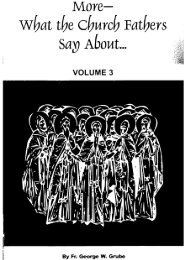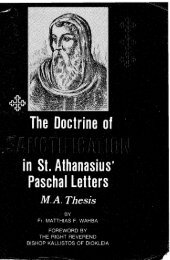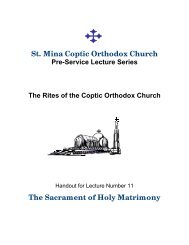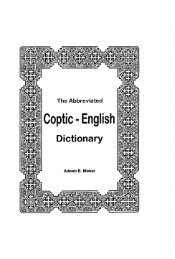Coptic interpretations of the Fourth Ecumenical Council - Saint Mina ...
Coptic interpretations of the Fourth Ecumenical Council - Saint Mina ...
Coptic interpretations of the Fourth Ecumenical Council - Saint Mina ...
Create successful ePaper yourself
Turn your PDF publications into a flip-book with our unique Google optimized e-Paper software.
Church. It is <strong>the</strong> teaching <strong>of</strong> <strong>the</strong> blessed Cyril on <strong>the</strong> hypostatic union <strong>of</strong> <strong>the</strong><br />
two natures in Christ that we both affirm, though we may use differing<br />
terminology to explain this teaching. We both teach that He who is<br />
consubstantial with <strong>the</strong> Fa<strong>the</strong>r according to Godhead became consubstantial also<br />
with us according to humanity in <strong>the</strong> Incarnation, that He who was before all<br />
ages begotten from <strong>the</strong> Fa<strong>the</strong>r, was in <strong>the</strong>se last days for us and for our<br />
salvation born <strong>of</strong> <strong>the</strong> blessed Virgin Mary, and that in Him <strong>the</strong> two natures are<br />
united in <strong>the</strong> one hypostasis <strong>of</strong> <strong>the</strong> Divine Logos, without confusion, without<br />
change, without division, without separation. Jesus Christ is perfect God and<br />
perfect man, with all <strong>the</strong> properties and faculties that belong to Godhead and<br />
to humanity.<br />
3. The human will and energy <strong>of</strong> Christ are nei<strong>the</strong>r absorbed nor suppressed by<br />
His divine will and energy, nor are <strong>the</strong> former opposed to <strong>the</strong> latter, but are<br />
united toge<strong>the</strong>r in perfect concord without division or confusion; He who wills<br />
and acts is always <strong>the</strong> One hypostasis <strong>of</strong> <strong>the</strong> Logos Incarnate. One is<br />
Emmanuel, God and Man, Our Lord and Saviour, Whom we adore and worship and who<br />
yet is one <strong>of</strong> us.<br />
4. We have become convinced that our agreement extends beyond Christological<br />
doctrine to embrace o<strong>the</strong>r aspects also <strong>of</strong> <strong>the</strong> au<strong>the</strong>ntic tradition, though we<br />
have not discussed all matters in detail. But through visits to each o<strong>the</strong>r,<br />
and through study <strong>of</strong> each o<strong>the</strong>r's liturgical traditions and <strong>the</strong>ological and<br />
spiritual writings, we have rediscovered, with a sense <strong>of</strong> gratitude to God,<br />
our mutual agreement in <strong>the</strong> common tradition <strong>of</strong> <strong>the</strong> One Church in all<br />
important matters liturgy and spirituality, doctrine and canonical practice,<br />
in our understanding <strong>of</strong> <strong>the</strong> Holy Trinity, <strong>of</strong> <strong>the</strong> Incarnation, <strong>of</strong> <strong>the</strong> Person<br />
and Work <strong>of</strong> <strong>the</strong> Holy Spirit, on <strong>the</strong> nature <strong>of</strong> <strong>the</strong> Church as <strong>the</strong> Communion <strong>of</strong><br />
<strong>Saint</strong>s with its ministry and Sacraments, and on <strong>the</strong> life <strong>of</strong> <strong>the</strong> world to come<br />
when our Lord and Saviour shall come in all his glory.<br />
5. We pray that <strong>the</strong> Holy Spirit may continue to draw us toge<strong>the</strong>r to find our<br />
full unity in <strong>the</strong> one Body <strong>of</strong> Christ. Our mutual agreement is not merely<br />
verbal or conceptual it is a deep agreement that impels us to beg our Churches<br />
to consummate our union by bringing toge<strong>the</strong>r again <strong>the</strong> two lines <strong>of</strong> tradition<br />
which have been separated from each o<strong>the</strong>r for historical reasons for such a<br />
long time. We work in <strong>the</strong> hope that our Lord will grant us full unity so that<br />
we can celebrate toge<strong>the</strong>r that unity in <strong>the</strong> Common Eucharist. That is our<br />
strong desire and final goal.<br />
SOME DIFFERENCES<br />
6. Despite our agreement on <strong>the</strong> substance <strong>of</strong> <strong>the</strong> tradition, <strong>the</strong> long period<br />
<strong>of</strong> separation has brought about certain differences in <strong>the</strong> formal expression<br />
<strong>of</strong> that tradition. These differences have to do with three basic<br />
ecclesiological issues - (a) <strong>the</strong> meaning and place <strong>of</strong> certain councils in <strong>the</strong><br />
life <strong>of</strong> <strong>the</strong> Church, (b) <strong>the</strong> ana<strong>the</strong>matization or acclamation as <strong>Saint</strong>s <strong>of</strong><br />
certain controversial teachers in <strong>the</strong> Church, and (c) <strong>the</strong> jurisdictional<br />
questions related to manifestation <strong>of</strong> <strong>the</strong> unity <strong>of</strong> <strong>the</strong> Church at local,<br />
regional and world levels.<br />
(a) Theologians from <strong>the</strong> Eastern Orthodox Church have drawn attention to <strong>the</strong><br />
fact that for <strong>the</strong>m <strong>the</strong> Church teaches that <strong>the</strong> seven ecumenical councils which<br />
<strong>the</strong>y acknowledge have an inner coherence and continuity that make <strong>the</strong>m a<br />
single indivisible complex to be viewed in its entirety <strong>of</strong> dogmatic<br />
definition. Theologians from <strong>the</strong> Oriental Orthodox Church feel, however, that<br />
<strong>the</strong> au<strong>the</strong>ntic Christological tradition has so far been held by <strong>the</strong>m on <strong>the</strong><br />
basis <strong>of</strong> <strong>the</strong> three ecumenical councils, supplemented by <strong>the</strong> liturgical and<br />
patristic tradition <strong>of</strong> <strong>the</strong> Church. It is our hope that fur<strong>the</strong>r study will lead<br />
to <strong>the</strong> solution <strong>of</strong> this problem by <strong>the</strong> decision <strong>of</strong> our Churches.<br />
As for <strong>the</strong> <strong>Council</strong>s and <strong>the</strong>ir authority for <strong>the</strong> tradition, we all agree<br />
that <strong>the</strong> <strong>Council</strong>s should be seen as charismatic events in <strong>the</strong> life <strong>of</strong> <strong>the</strong><br />
Church ra<strong>the</strong>r than as an authority over <strong>the</strong> Church; where some <strong>Council</strong>s are<br />
acknowledged as true <strong>Council</strong>s, whe<strong>the</strong>r as ecumenical or as local, by <strong>the</strong><br />
Church's tradition, <strong>the</strong>ir authority is to be seen as coming from <strong>the</strong> Holy<br />
Spirit. Distinction is to be made not only between <strong>the</strong> doctrinal definitions<br />
and canonical legislations <strong>of</strong> a <strong>Council</strong>, but also between <strong>the</strong> true intention<br />
<strong>of</strong> <strong>the</strong> dogmatic definition <strong>of</strong> a <strong>Council</strong> and <strong>the</strong> particular terminology in<br />
which it is expressed, which latter has less authority than <strong>the</strong> intention.<br />
(b) The reuniting <strong>of</strong> <strong>the</strong> two traditions which have <strong>the</strong>ir own separate<br />
continuity poses certain problems in relation to certain revered teachers <strong>of</strong><br />
13


